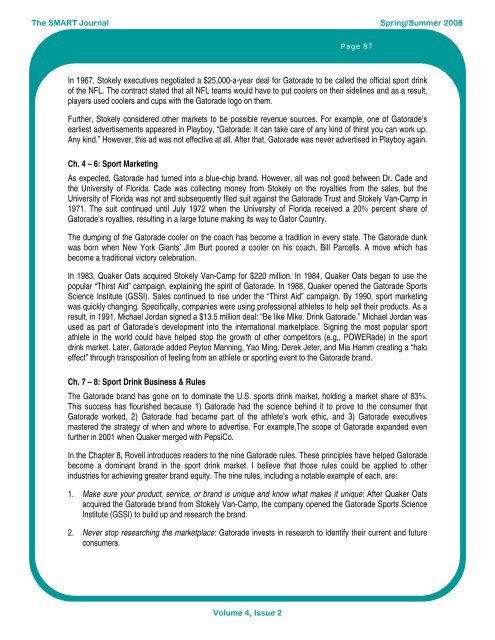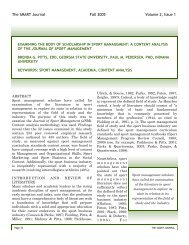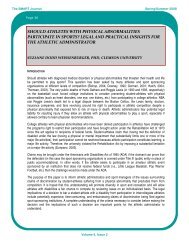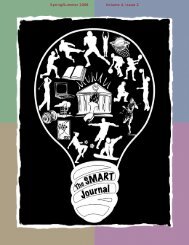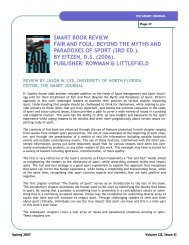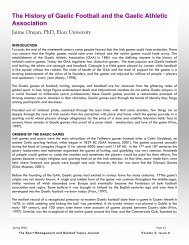Create successful ePaper yourself
Turn your PDF publications into a flip-book with our unique Google optimized e-Paper software.
<strong>The</strong> <strong>SMART</strong> <strong>Journal</strong> Spr<strong>in</strong>g/Summer 2008Page 87In 1967, Stokely executives negotiated a $25,000-a-year deal for Gatorade to be called the official sport dr<strong>in</strong>kof the NFL. <strong>The</strong> contract stated that all NFL teams would have to put coolers on their sidel<strong>in</strong>es and as a result,players used coolers and cups with the Gatorade logo on them.Further, Stokely considered other markets to be possible revenue sources. For example, one of Gatorade’searliest advertisements appeared <strong>in</strong> Playboy, “Gatorade: It can take care of any k<strong>in</strong>d of <strong>thirst</strong> you can work up.Any k<strong>in</strong>d.” However, this ad was not effective at all. After that, Gatorade was never advertised <strong>in</strong> Playboy aga<strong>in</strong>.Ch. 4 – 6: Sport Market<strong>in</strong>gAs expected, Gatorade had turned <strong>in</strong>to a blue-chip brand. However, all was not good between Dr. Cade andthe University of Florida. Cade was collect<strong>in</strong>g money from Stokely on the royalties from the sales, but theUniversity of Florida was not and subsequently filed suit aga<strong>in</strong>st the Gatorade Trust and Stokely Van-Camp <strong>in</strong>1971. <strong>The</strong> suit cont<strong>in</strong>ued until July 1972 when the University of Florida received a 20% percent share ofGatorade’s royalties, result<strong>in</strong>g <strong>in</strong> a large fotune mak<strong>in</strong>g its way to Gator Country.<strong>The</strong> dump<strong>in</strong>g of the Gatorade cooler on the coach has become a tradition <strong>in</strong> every state. <strong>The</strong> Gatorade dunkwas born when New York Giants’ Jim Burt poured a cooler on his coach, Bill Parcells. A move which hasbecome a traditional victory celebration.In 1983, Quaker Oats acquired Stokely Van-Camp for $220 million. In 1984, Quaker Oats began to use thepopular “Thirst Aid” campaign, expla<strong>in</strong><strong>in</strong>g the spirit of Gatorade. In 1988, Quaker opened the Gatorade SportsScience Institute (GSSI). Sales cont<strong>in</strong>ued to rise under the “Thirst Aid” campaign. By 1990, sport market<strong>in</strong>gwas quickly chang<strong>in</strong>g. Specifically, companies were us<strong>in</strong>g professional athletes to help sell their products. As aresult, <strong>in</strong> 1991, Michael Jordan signed a $13.5 million deal: “Be like Mike. Dr<strong>in</strong>k Gatorade.” Michael Jordan wasused as part of Gatorade’s development <strong>in</strong>to the <strong>in</strong>ternational marketplace. Sign<strong>in</strong>g the most popular sportathlete <strong>in</strong> the world could have helped stop the growth of other competitors (e.g., POWERade) <strong>in</strong> the sportdr<strong>in</strong>k market. Later, Gatorade added Peyton Mann<strong>in</strong>g, Yao M<strong>in</strong>g, Derek Jeter, and Mia Hamm creat<strong>in</strong>g a “haloeffect” through transposition of feel<strong>in</strong>g from an athlete or sport<strong>in</strong>g event to the Gatorade brand.Ch. 7 – 8: Sport Dr<strong>in</strong>k Bus<strong>in</strong>ess & Rules<strong>The</strong> Gatorade brand has gone on to dom<strong>in</strong>ate the U.S. sports dr<strong>in</strong>k market, hold<strong>in</strong>g a market share of 83%.This success has flourished because 1) Gatorade had the science beh<strong>in</strong>d it to prove to the consumer thatGatorade worked, 2) Gatorade had became part of the athlete’s work ethic, and 3) Gatorade executivesmastered the strategy of when and where to advertise. For example,<strong>The</strong> scope of Gatorade expanded evenfurther <strong>in</strong> 2001 when Quaker merged with PepsiCo.In the Chapter 8, Rovell <strong>in</strong>troduces readers to the n<strong>in</strong>e Gatorade rules. <strong>The</strong>se pr<strong>in</strong>ciples have helped Gatoradebecome a dom<strong>in</strong>ant brand <strong>in</strong> the sport dr<strong>in</strong>k market. I believe that those rules could be applied to other<strong>in</strong>dustries for achiev<strong>in</strong>g greater brand equity. <strong>The</strong> n<strong>in</strong>e rules, <strong>in</strong>clud<strong>in</strong>g a notable example of each, are:1. Make sure your product, service, or brand is unique and know what makes it unique: After Quaker Oatsacquired the Gatorade brand from Stokely Van-Camp, the company opened the Gatorade Sports ScienceInstitute (GSSI) to build up and research the brand.2. Never stop research<strong>in</strong>g the marketplace: Gatorade <strong>in</strong>vests <strong>in</strong> research to identify their current and futureconsumers.Volume 4, Issue 2


